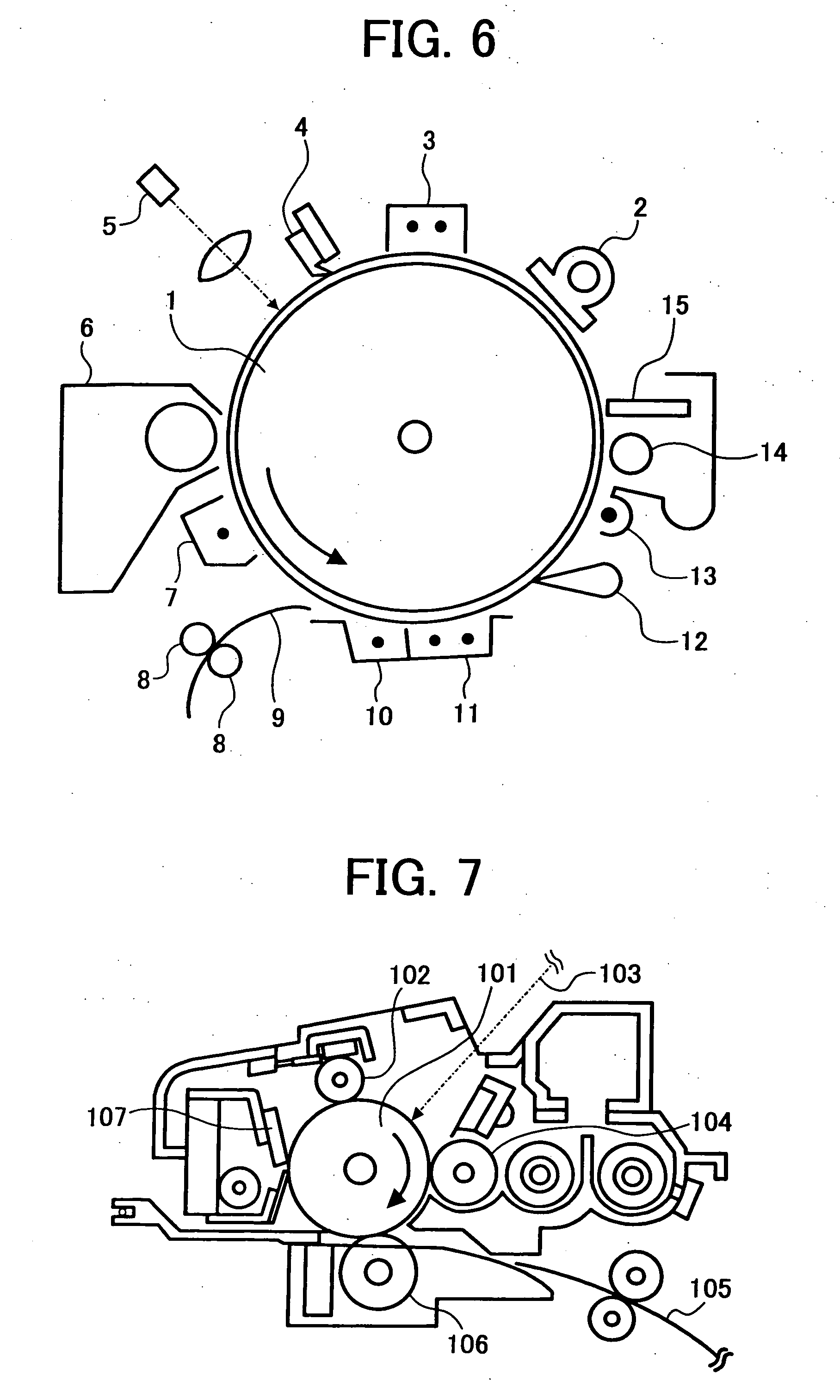Image forming method, image forming apparatus and process cartridge therefor
a technology of image forming apparatus and process cartridge, which is applied in the direction of electrographic process apparatus, corona discharge, instruments, etc., can solve the problems of insufficient photographic image production, insufficient development of ultra high-resolution electrophotographic image forming apparatus, etc., and achieve high durability, high resolution, and stably producing high-quality images.
- Summary
- Abstract
- Description
- Claims
- Application Information
AI Technical Summary
Benefits of technology
Problems solved by technology
Method used
Image
Examples
example 1
[0234] An undercoat coating liquid, a charge generation coating liquid and charge transport coating liquid, which have the following formulations, were coated in this order on an aluminum cylinder having a diameter of 30 mm and dried to form an undercoat layer of 3.5 μm thick, a CGL of 0.2 μm thick and a CTL of 14 μm thick thereon. The CTL was further coated with a crosslinked surface layer coating liquid having the following formulation by a spray coating method. The coated layer was irradiated with a metal halide lamp at a light quantity of 160 W / cm, a distance of 120 mm and an irradiation intensity of 600 mW / cm2 for 60 sec, and further dried at 130° C. for 30 min to form a crosslinked surface layer having a thickness of 2 μm. Thus prepared electrophotographic photoreceptor was evaluated by the above-mentioned method.
[0235] Undercoat Layer Coating Liquid
Undercoat layer coating liquidAlkyd resin6(BEKKOZOL1307-60-EL from Dainippon Ink & Chemicals, Inc.)Melamine resin4(SUPER BEKKA...
example 2
[0236] An undercoat layer was formed on an aluminum cylinder by the same method as that of Example 1. Next, 1.5 parts of Y-type oxytitanitmphthalocyanine, 1 part of polyester resin (VYLON 200 from Toyobo Co., Ltd.) and 500 parts of a dichloromethane solution having a concentration of 0.5% were pulverized and mixed by a ball mill to prepare a dispersion, and the dispersion was coated on the undercoat layer to form a CGL having a thickness of 0.2 μm thereon. Next, 10 parts of a CTM having the following formula (c) and 10 parts of a polycarbonate resin (PANLITE C-1400 from Teijin Limited) were dissolved in tetrahydrofuran to prepare a CTL coating liquid, and the CTL coating liquid was coated on the CGL to form a CTL having a thickness of 15 μm thereon.
[0237] The procedures of preparation and evaluation of the electrophotographic photoreceptor in Example 1 were repeated except for changing the radical polymerizing monomer having three or more functional groups without a charge transpo...
example 3
[0238] The procedures of preparation and evaluation of the electrophotographic photoreceptor in Example 1 were repeated except for changing the radical polymerizing monomer having three or more functional groups without a charge transport structure included in the crosslinked surface layer coating liquid into the following monomer, the polymerization initiator into the following compound, the thickness of the CTL into 13 μm and the thickness of the crosslinked surface layer into 3 μm.
Radical polymerizing monomer10having three or more functional groupswithout a charge transport structurepentaerythritoltetraacrylate(SR-295 from NIPPON KAYAKU CO., LTD.)having a molecular weight (Mw) of 352,4 functional groups and Mw / 4 of 88Photo polymerization initiator12,4-diethylthioxantone(KAYACURE DETX-S from NIPPON KAYAKU CO., LTD.)
PUM
 Login to View More
Login to View More Abstract
Description
Claims
Application Information
 Login to View More
Login to View More - R&D
- Intellectual Property
- Life Sciences
- Materials
- Tech Scout
- Unparalleled Data Quality
- Higher Quality Content
- 60% Fewer Hallucinations
Browse by: Latest US Patents, China's latest patents, Technical Efficacy Thesaurus, Application Domain, Technology Topic, Popular Technical Reports.
© 2025 PatSnap. All rights reserved.Legal|Privacy policy|Modern Slavery Act Transparency Statement|Sitemap|About US| Contact US: help@patsnap.com



